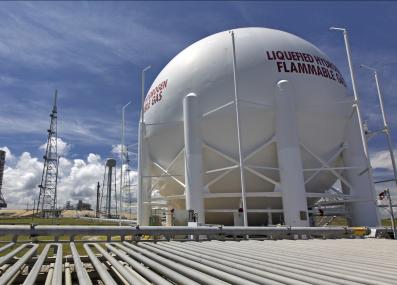Have a question?
Can we use the pipelines and power plants we have now to transport and burn hydrogen, or do we need new infrastructure?
Most legacy pipelines and power plants built for natural gas would need to be retrofitted or replaced to use hydrogen—except as a small percentage of a blend with natural gas.
March 29, 2023
Today, hydrogen is used in a number of industrial processes, particularly for refining oil and producing ammonia for fertilizer. But as the world economy transitions to running on clean energy, companies and policymakers hope to use more “green” or “renewable” hydrogen—produced with clean electricity and water instead of climate-warming methane gas—both to replace existing hydrogen sources, and to power other climate-polluting industries like steel and cement.
But scaling up hydrogen use will require dramatically growing the 1,600 miles of pipelines in the U.S. that currently transport it. Many companies have looked to the 3 million miles of natural gas pipelines as a potential transportation network, but the chemical properties of hydrogen will make that a challenge. “The bottom line: it is not as straightforward as just pushing through hydrogen in existing infrastructure,” says Emre Gençer, a principal research scientist at the MIT Energy Initiative. “Either it should be retrofitted or we need new infrastructure.”
Here’s why.
The pipelines that transport hydrogen are made of the same basic material as most of those built for natural gas: steel. But hydrogen is a much smaller molecule than methane, the main component in natural gas. In fact, hydrogen is the smallest molecule on Earth. Its size means it can squeeze into tiny spaces in certain steel alloys in a way that natural gas cannot. That can cause “embrittlement,” making the metal more likely to crack or corrode. Hydrogen molecules are also much more likely to leak from valves, seals, and other connection points on pipelines (which risks undermining green hydrogen’s climate benefits1). And hydrogen is transported in a more pressurized state than natural gas, which puts more stress on the pipeline carrying it.
Rather than transporting 100 percent hydrogen, many companies are now testing whether they can blend hydrogen with natural gas for transport in existing pipelines. In a study released last summer, the California Public Utility Commission found that up to 5 percent hydrogen blended with natural gas appears safe, but higher percentages could lead to embrittlement or a greater chance of pipeline leaks.2 Internationally, France places the highest cap on hydrogen blending, at 6 percent, according to the International Energy Agency (Germany allows blending at 8 percent under certain conditions).3
Supporters of blending say it can reduce the climate-warming greenhouse gas emissions from burning natural gas. But mixing hydrogen with natural gas, even if the hydrogen is produced from entirely clean electricity, lowers gas emissions by only a very small amount, says Gençer. Hydrogen also has a lower “energy density,” so we need to burn more of it to get the same amount of energy we get from burning methane.
As for using hydrogen to make energy in power plants, today’s plants appear able to run on hydrogen blends between 20 to 40 percent, says Gençer. At higher levels, a facility would need to undergo major upgrades or in some cases be completely updated. Current household appliances that use natural gas, like stoves, can tolerate blending at much lower levels. Gençer says it makes the most sense to focus early uses of green hydrogen in industries that already rely on hydrogen, rather than creating entirely new uses.
“The lower hanging fruit right now is really replacing the existing industrial demand for hydrogen from fossil-based to cleaner options,” he says.
Thank you to Scott MacKenzie of Pocatello, Idaho, for the question. You can submit your own question to Ask MIT Climate here.
1 Reuters: "Has green hydrogen sprung a leak?" Sarah Mcfarlane and Ron Bousso, December 22, 2022.
2 California Public Utilities Commission: "Hydrogen Blending Impacts Study," 2022.
3 International Energy Agency: "Current limits on hydrogen blending in natural gas networks and gas demand per capita in selected locations." Accessed March 15, 2023.







